How it Works: Preen Garden Weed Preventers
Here's how our Garden Weed Preventers prevent weeds before they even sprout rather than killing them after they’ve already had the chance to grow.
Both beginning and experienced veteran gardeners are looking to cut down on high maintenance or “fussy” plants. As a result, many fall-planting nursery and garden center consumers are in the market for low-care plant choices. The good news is that there are plenty of “survivor plants” available that perform well in most landscapes across the country with only limited care while looking good at the same time. Some are fairly well known and widely grown. Others go under-planted simply because people may not have heard of them.
Numerous and superb new varieties (or cultivars) are now available for this cold-hardy, summer-blooming shrub, that bloom with cones of white-to-pink flowers. Some 4' to 5' dwarf types include Little Lime®, Bobo®, and Little Quick Fire®. 'Limelight', Pinky Winky®, and Quick Fire® are larger at 7'-8' tall. (Sun to part shade, winter-hardy in Zones 4-8.)
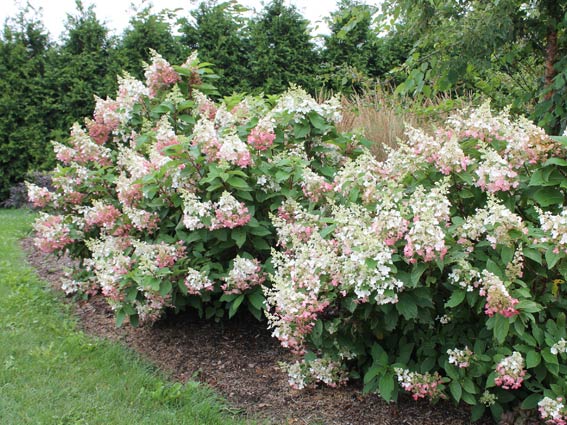
Hydrangea Pinky Winky® is a summer-blooming panicle hydrangea with cone-shaped flowers that start white and turn rosy-pink. © George Weigel
This spring-blooming, 3'-5' shrub resembles more of a small golden willow than a typical ball-shaped spirea. The finely textured leaves are slender and turn coppery in fall. Dainty, snow-white flowers cover the plant in early spring. (Sun to part shade, Zones 4-8.) (Mellow Yellow®). Also know as 'Ogon'.
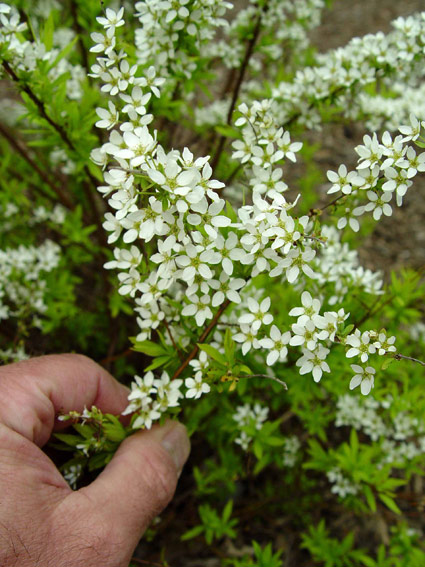
Spirea 'Ogon' (Mellow Yellow®) is a durable flowering shrub with narrow golden foliage, and that’s covered with white flowers in early spring. © George Weigel
The Knock Out ® series and David Austin's English Roses are best known, but other series as lower-growing Drift® (18"-24"), Oso Easy® (12"-24") and Flower Carpet® (24"-30") give a long bloom time with multiple color options. They thrive with little care other than an annual or twice-a-year cutback. (Sun, Zones 5-10.)
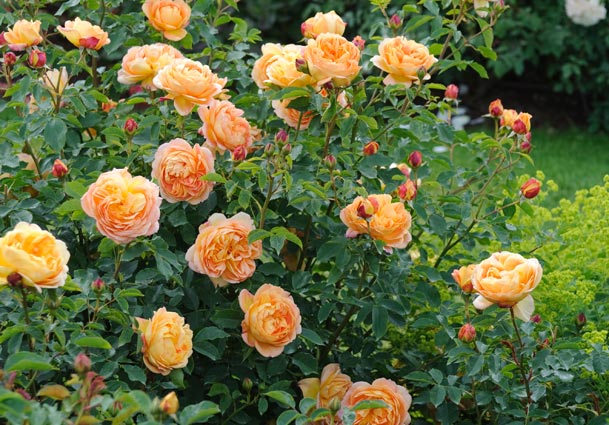
The apricot-salmon flowers of the shrub rose 'Lady of Shalott' is thought to be even more beautiful in fall than earlier in the season. Photo courtesy of David Austin Roses
This heat- and drought-tolerant genus has succulent foliage, which makes them non-favorites of deer and rodents. Many have pink flower heads that top bushy, upright plants 2'- 3' tall, with large, fleshy leaves; others are yellow-flowering, creeping species that hug the ground at 2"-3", with needle-like blue-green, golden, or burgundy leaves. 'Autumn Joy,' 'Autumn Fire,' 'Neon', and 'Brilliant' are good uprights, while 'Angelina,' 'Weihenstephaner Gold', and 'Fuldaglut' are good creepers. (Sun, Zones 4-9.)
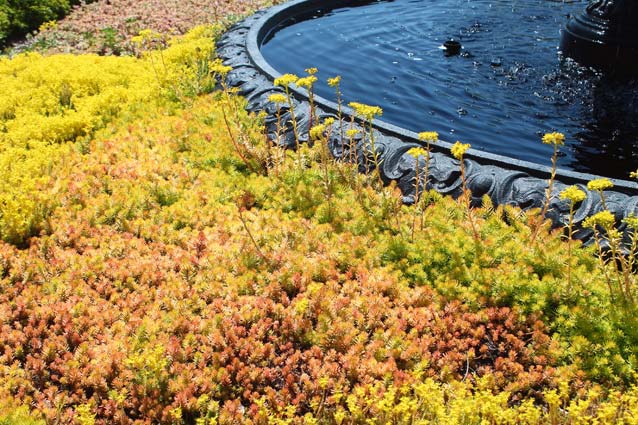
Creeping Sedum ‘Angelina’ makes a golden carpet all summer, and becomes brilliant orange in cold winters. 3" tall.
Also called Bishop's hat in reference to the shape of their flowers, these tough, deer-resistant perennials have leathery heart-shaped leaves, often marked with red or rose in spring. Dangling bell-shaped yellow, pink, lilac, or white flowers appear in spring. Most grow only about 1' tall. Especially good varieties include yellow-flowered 'Frohnleiten' and 'Sulphureum', E. grandiflorum 'Album' and red 'Rubrum'. One of the best choices for groundcover in dry shade under trees. (Shade or part shade, Zones 5-9.)
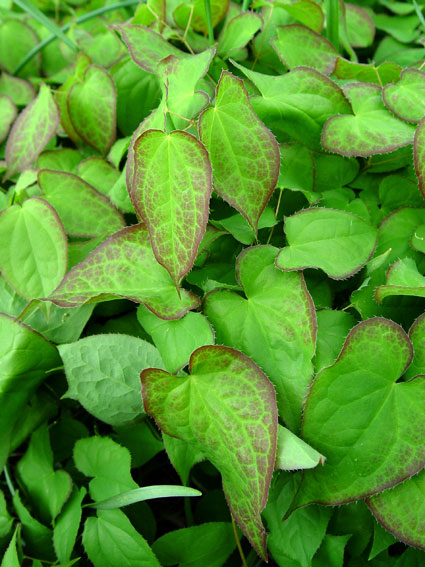
Barrenwort 'Rubrum' has heart-shaped leaves that start out with tinges of burgundy in spring. © George Weigel
Switchgrass is a native ornamental grass that's not picky about soil growing both in hot, dry areas or cool, damp ones. The leaf blades grow about 3' tall and turn burgundy in fall. The seed heads rise another foot or so in summer; they are dainty and pink/burgundy-tinted as opposed to plumes. 'Northwind' and 'Dallas Blues' are good blue-leafed varieties, while 'Hanse Herms' and 'Shenandoah' have green leaves with some of the best fall color. (Sun, Zones 2-9.)
Despite the mint in the name, catmint doesn't "run around" as aggressively as spearmint and peppermint do. This 15"-24" tall, heat- and drought tolerant perennial grows in gradually-spreading clumps that bloom most of the season from June till frost, especially when cut back after the first flush of blooms fade. Flowers are usually blue, and leaves are grayish-green. 'Walker's Low' (2'-2.5') is most popular, but 'Kit Cat' (12"-18"), 'Blue Ice' (white-flowered, 6”-10”), and Junior Walker™ (18") are other good cultivars. (Sun, Zones 3-8.)
Apart from culinary sage, S. officinalis and its cultivars, the best-known members of this huge genus are the meadow sages ('May Night', 'Caradonna', and their cousins), 18"-30" perennials with spikes of purple-blue flowers in late spring and sometimes again in early fall. Many other species, cultivars, and hybrids are available however. Several, including red sage (S. splendens) and blue sage (S. farinacea) are generally treated as annuals; several others (gentian sage, S. patens, Mexican bush sage, S. leucantha, and pineapple sage, S.elegans for example) are perfect as annuals in the north, and as year-round perennials in mild winter climates in Zone 7 and warmer. Flowers may be blue, red, or rosy-pink. All are among the longest blooming and most heat- and drought-tolerant of flowers. (Sun, Zones 5-9.)
Sometimes called "witch alder," fothergillas may be 2'-10' tall according to species and selection. They are native, under-used and trouble-free shrubs, with small white, bottlebrush flowers in spring and eye-popping red/gold/orange fall foliage. 'Mt. Airy' (3'-5') and 'Blue Shadow' (4'-6') are particularly good choices. (Shade to part shade, Zones 5-8.)
It's hard to go wrong with anything in this large genus of flowering shrubs, some of which are native. Most viburnums show off fragrant white flowers in spring, bright autumn foliage, and orange-red, red, blue-black, black, or yellow fruits in fall. Sizes range from 5'-10' (Sun to shade, Zones 2-11, depending on type.)
Many conifers are prone to bugs and diseases, but Hinoki cypress is one of the least susceptible. Dwarf types are especially valued in foundation plantings, due to their slow growth and compact or narrow sizes. 'Nana Gracilis' (ultimately 6') is a favorite for flanking doorways or softening house corners. 'Nana Lutea' (18"-36") has fans of beautiful golden leaves. (Sun to part shade Zones 5-8.)
Another tough conifer, falsecypress has a shaggy habit with soft, lacy foliage, either golden or green. Full-sized plants can grow upwards of 12' tall, while dwarf 'Golden Mop' stays closer to 5' or 6' tall and wide. 'Filifera Nana' is 2'-3' tall. (Sun to part shade, Zones 4-8.)